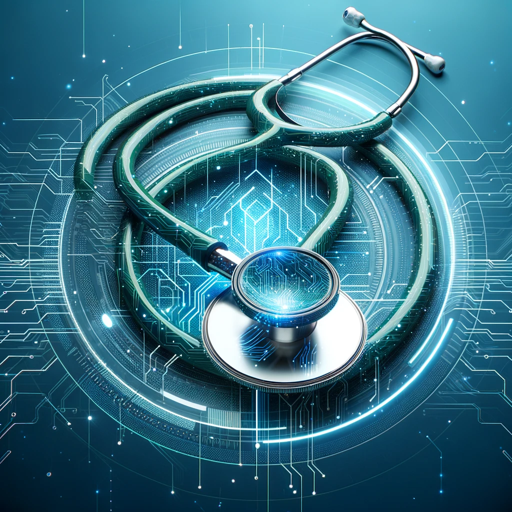Guide for medical education-AI-powered medical education resource
AI-powered medical learning made simple
How is pancreatic cancer diagnosed and treated?
What are the causes and symptoms of colon cancer?
What are the latest treatments for prostate cancer?
What are the symptoms, diagnosis, and treatment of diabetes?
Explain the types of diabetes medications and how they work.
Describe the electrocardiogram findings in angina pectoris
What is a good exercise regimen for people with lumbar disc herniation?
What are the causes, symptoms, and treatment of depression?
Describe the types of antihypertensive medications and how each works.
Related Tools
Load More
Clinical Medicine Handbook
I can assist doctors with information synthesis, medical literature reviews, patient education material, diagnostic guidelines, treatment options, ethical dilemmas, and staying updated on medical research and innovations.

AI for Medical Students
Medical Study AI aids in Medical Assistant learning, AI for Medical Students, understanding Medical Terminology, navigating Medical School, and Molecular Biology concepts. It's an essential tool for medical education and knowledge.

Clinical Medicine Handbook
I support doctors and nurses to synthesize information, conducting comprehensive reviews of medical literature, presenting treatment alternatives, offering guidance on diagnoses, patient education resources, ethical challenges, and ensuring awareness of a

Med School Interview Mentor
Assists with med school interview(s), including MMI preparation. Can grade your answers to an interview question and help improve them. Can also provide some example questions and practice an interview scenario with you.

Medicine Companion - For Medical Students
Medical flashcard creator based on NICE guidelines + access to drug information. It can also answer medicine related questions with good knowledge base and access to reputable websites such as NICE when unsure.

Medi Expert
Adapts language for both professionals and general audiences, focusing on latest medical research.
20.0 / 5 (200 votes)
Guide for Medical Education: Purpose and Design
Guide for Medical Education is designed as a comprehensive resource for individuals seeking to deepen their understanding of medical topics. Its primary purpose is to provide detailed insights into medical conditions, diagnostic processes, treatment protocols, and the latest advancements in the medical field. It is tailored for a diverse audience, including medical students, professionals, and anyone with an interest in healthcare. The Guide emphasizes practical knowledge application, making it a valuable tool for both learning and clinical practice. For example, if a medical student is studying the anatomy of muscles, the Guide not only offers anatomical diagrams but also explains muscle functions, origins, insertions, and implications of injuries, supported by treatment guidelines.

Core Functions of Guide for Medical Education
Comprehensive Medical Knowledge
Example
Provides in-depth explanations of diseases, including their etiology, symptoms, and treatment options.
Scenario
A medical student preparing for exams can use the Guide to review the pathophysiology of diabetes mellitus, from its cellular mechanisms to its systemic effects.
Anatomical Visualization
Example
Offers detailed images of human anatomy, highlighting bones, muscles, and nerves.
Scenario
A student learning musculoskeletal anatomy can refer to diagrams showing muscle origins and insertions, aiding in understanding complex structures like the rotator cuff.
Clinical Application Guidance
Example
Describes rehabilitation and strengthening exercises for muscle injuries.
Scenario
A physical therapist can consult the Guide for protocols on rehabilitating a patient with a torn hamstring, including specific exercises and progression timelines.
Target Users of Guide for Medical Education
Medical Students
Students pursuing medical degrees can benefit from the Guide as it offers structured content relevant to their curriculum, including detailed explanations, diagrams, and practical examples that help in mastering complex topics.
Healthcare Professionals
Doctors, nurses, and therapists can use the Guide to stay updated on medical advancements, refine diagnostic skills, and find detailed treatment plans, making it a valuable resource in both educational and clinical settings.

How to Use Guide for Medical Education
Visit aichatonline.org for a free trial without login
Access the platform by visiting the official website. No registration or ChatGPT Plus subscription is required to start exploring the resources available.
Explore available medical topics
Browse through a wide array of medical topics ranging from basic sciences to advanced clinical medicine. Use the search function to find specific subjects or areas of interest.
Engage with detailed content
Read through the in-depth explanations, diagrams, and illustrations provided for each topic. Take notes, bookmark important sections, and utilize embedded links to related topics for a comprehensive understanding.
Utilize interactive tools
Use tools such as quizzes, flashcards, and case studies to reinforce learning. These tools are designed to test your knowledge and enhance retention of the material.
Apply the knowledge in practical scenarios
Integrate what you've learned into real-world medical situations, whether you're studying for exams, conducting research, or practicing in a clinical setting.
Try other advanced and practical GPTs
水彩画家
AI-powered watercolor artistry at your command.

MJ V6 Prompt Generator
AI-powered prompt generation for MidJourney.

Racket Programming Assistant
AI-powered assistance for Racket developers

Colorizer Pro
Bring your photos to life with AI

Hardware Mastermind
AI-powered tool for hardware mastery

Software Mastermind
Build smarter software with AI-driven precision.

Academic Discussion Post Reply
AI-Powered Academic Discussion Support

Get Her Hired
AI-powered tool for executive resume perfection.

Sketch Artist
AI-powered sketch art creator for everyone

SF Admin Helper
AI-powered tool for seamless Salesforce management.

Portrait Creator(似顔絵クリエイター)
AI-powered Portrait Creator

Pyth-on Point
AI-powered Python coding expert

- Exam Prep
- Case Studies
- Medical Research
- Clinical Practice
- Student Learning
Guide for Medical Education: Common Questions
What types of medical topics are covered?
Guide for Medical Education offers comprehensive coverage of various medical fields, including anatomy, pharmacology, internal medicine, surgery, and more. It provides detailed explanations suitable for both students and professionals.
How can I use the platform without registering?
Simply visit aichatonline.org, where you can access a free trial without needing to create an account. The platform is designed to be user-friendly and immediately accessible.
Are there interactive learning tools available?
Yes, the platform includes interactive tools such as quizzes, flashcards, and case studies to help reinforce your understanding and retention of the material.
Is the content updated regularly?
Yes, Guide for Medical Education continuously updates its content to reflect the latest medical research and advancements, ensuring that users have access to the most current information.
Can I use this tool for exam preparation?
Absolutely. The detailed explanations, interactive tools, and comprehensive coverage of topics make it an excellent resource for preparing for medical exams and certifications.